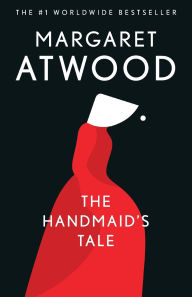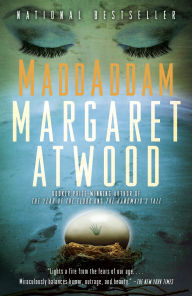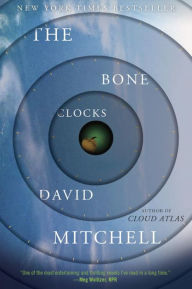The Future Library Is a Vote of Confidence Humanity Will Make It to 2114
 You thought waiting for the remaining volumes of A Song of Ice and Fire was bad. How about waiting nearly a hundred years to read a book from Margaret Atwood (The Handmaid’s Tale and the MaddAddam trilogy) or David Mitchell (Cloud Atlas and The Bone Clocks)?
You thought waiting for the remaining volumes of A Song of Ice and Fire was bad. How about waiting nearly a hundred years to read a book from Margaret Atwood (The Handmaid’s Tale and the MaddAddam trilogy) or David Mitchell (Cloud Atlas and The Bone Clocks)?
The Handmaid's Tale
The Handmaid's Tale
In Stock Online
Paperback $18.00
The work of Scottish artist Katie Paterson is nothing as mundane as oil on canvas or carved marble. Her works includes Timepieces—nine clocks showing the time on the planets of our solar system, plus the Earth’s moon (Pluto still loses out); Fossil Necklace—170 beads carved from fossils, each representing a major event in the 3 billion year history of life on Earth; and Campo del Cielo, Field of Sky—a 4.5 billion year old meteorite, melted then recast into a replica of its original form, and finally returned to space by the European Space Agency.
In May 2014, Paterson planted 1000 Norwegian spruce trees in a forest north of Oslo, Norway. The plan is to harvest them in 2114 for paper to print a limited edition anthology of books. Each year, starting in 2014, an author was to be invited to write a book for Paterson’s project, Future Library; he or she will have one year to complete the work, which then won’t be read until well after the turn of the next century.
The work of Scottish artist Katie Paterson is nothing as mundane as oil on canvas or carved marble. Her works includes Timepieces—nine clocks showing the time on the planets of our solar system, plus the Earth’s moon (Pluto still loses out); Fossil Necklace—170 beads carved from fossils, each representing a major event in the 3 billion year history of life on Earth; and Campo del Cielo, Field of Sky—a 4.5 billion year old meteorite, melted then recast into a replica of its original form, and finally returned to space by the European Space Agency.
In May 2014, Paterson planted 1000 Norwegian spruce trees in a forest north of Oslo, Norway. The plan is to harvest them in 2114 for paper to print a limited edition anthology of books. Each year, starting in 2014, an author was to be invited to write a book for Paterson’s project, Future Library; he or she will have one year to complete the work, which then won’t be read until well after the turn of the next century.
MaddAddam (MaddAddam Trilogy #3)
MaddAddam (MaddAddam Trilogy #3)
In Stock Online
Paperback $18.00
The completed manuscripts will be kept in a specially designed room on the fifth floor of the New Deichmanske Library in Oslo. The authors’ names and the book titles will be on display, but the manuscripts themselves will be unread until the anthology is published in 2114. In a 2014 interview, Paterson opined that the books will be safe there, even if the Norwegian fjords drown the land. But then, they also thought the Svalbard Global Seed Bank was secure when established in 2008 on a Norwegian island above the Article Circle. The permafrost still melted there this year, flooding the entrance to the seed bank. (No seeds were harmed, but there is probably a lot more melting in our future.)
According to the Future Library website, “The authors are being selected for their outstanding contributions to literature and poetry and for their works’ ability to capture the imagination of this and future generations. Key words in the selection process are ‘imagination’ and ‘time’. The [Future Library] Trust is inviting one hundred outstanding writers of any nationality or age to contribute works in any genre or language. The length of the piece is entirely for the author to decide.”
The completed manuscripts will be kept in a specially designed room on the fifth floor of the New Deichmanske Library in Oslo. The authors’ names and the book titles will be on display, but the manuscripts themselves will be unread until the anthology is published in 2114. In a 2014 interview, Paterson opined that the books will be safe there, even if the Norwegian fjords drown the land. But then, they also thought the Svalbard Global Seed Bank was secure when established in 2008 on a Norwegian island above the Article Circle. The permafrost still melted there this year, flooding the entrance to the seed bank. (No seeds were harmed, but there is probably a lot more melting in our future.)
According to the Future Library website, “The authors are being selected for their outstanding contributions to literature and poetry and for their works’ ability to capture the imagination of this and future generations. Key words in the selection process are ‘imagination’ and ‘time’. The [Future Library] Trust is inviting one hundred outstanding writers of any nationality or age to contribute works in any genre or language. The length of the piece is entirely for the author to decide.”
The Bone Clocks
The Bone Clocks
In Stock Online
Paperback $19.00
The first writer invited to contribute to the Future Library was Margaret Atwood, who wrote a book called Scribbler Moon for the project. For the ceremony during which she handed over her manuscript, Atwood wrote, “Will any human beings be waiting there to receive it? Will there be a ‘Norway?’ Will there be a ‘forest?’ Will there be a ‘library?’ How strange it is to think of my own voice—silent by then for a long time—suddenly being awakened, after 100 years.”
David Mitchell was the second author, selected in 2015. His book is titled From Me Flows What You Call Time. Mitchell called it “a vote of confidence in civilization.” He said writing a book for the Future Library was a way to express his belief that, “the side [of humanity] that values reading, that values seeing things from other people’s point of view, which is the forte of the novel—that currently embattled side has an equal shot at influencing the future.”
The first writer invited to contribute to the Future Library was Margaret Atwood, who wrote a book called Scribbler Moon for the project. For the ceremony during which she handed over her manuscript, Atwood wrote, “Will any human beings be waiting there to receive it? Will there be a ‘Norway?’ Will there be a ‘forest?’ Will there be a ‘library?’ How strange it is to think of my own voice—silent by then for a long time—suddenly being awakened, after 100 years.”
David Mitchell was the second author, selected in 2015. His book is titled From Me Flows What You Call Time. Mitchell called it “a vote of confidence in civilization.” He said writing a book for the Future Library was a way to express his belief that, “the side [of humanity] that values reading, that values seeing things from other people’s point of view, which is the forte of the novel—that currently embattled side has an equal shot at influencing the future.”
From the Mouth of the Whale
From the Mouth of the Whale
By
Sjón
Translator
Victoria Cribb
In Stock Online
Paperback $18.00
The third author chosen was Icelandic poet, novelist, and lyricist Sjón. You might be familiar with some of his work without knowing it, since he frequently collaborates with pop singer Björk. He wrote the lyrics for her song “I’ve Seen It All,” which was nominated for an Oscar in 2000. (It lost to Nobel winner Bob Dylan’s “Things Have Changed.”) The English translation of the title of his Future Library manuscript is VII: As My Brow Brushes on the Tunics of Angels or The Drop Tower, the Roller Coaster, the Whirling Cups and Other Instruments of Worship from the Post-Industrial Age. (It probably rolls off the tongue easier in the original Icelandic.) Sjón compared the Future Library project to the cathedrals of Europe that took 200 to 300 years to make. “They were generational projects,” he said. “Maybe with all the challenges we are facing today, like climate change, we need more projects that help us to think in generations.”
If you are planning generations of your own (or are counting on life extension technology to get your own consciousness to 2114), you can preorder a copy of the anthology for £800 (unfortunately, it’s not yet available from Barnes & Noble). In a 2014 interview about the anthology, Paterson said, “I don’t know who’ll read them. Maybe they’ll be like the characters in Margaret’s books.” Was she thinking of Offred, Oryx, Crake, or the Crakers? The important thing is that she, Atwood, Mitchell, Sjón—and all of us— remember to think about the future, so we might have a better one.
The third author chosen was Icelandic poet, novelist, and lyricist Sjón. You might be familiar with some of his work without knowing it, since he frequently collaborates with pop singer Björk. He wrote the lyrics for her song “I’ve Seen It All,” which was nominated for an Oscar in 2000. (It lost to Nobel winner Bob Dylan’s “Things Have Changed.”) The English translation of the title of his Future Library manuscript is VII: As My Brow Brushes on the Tunics of Angels or The Drop Tower, the Roller Coaster, the Whirling Cups and Other Instruments of Worship from the Post-Industrial Age. (It probably rolls off the tongue easier in the original Icelandic.) Sjón compared the Future Library project to the cathedrals of Europe that took 200 to 300 years to make. “They were generational projects,” he said. “Maybe with all the challenges we are facing today, like climate change, we need more projects that help us to think in generations.”
If you are planning generations of your own (or are counting on life extension technology to get your own consciousness to 2114), you can preorder a copy of the anthology for £800 (unfortunately, it’s not yet available from Barnes & Noble). In a 2014 interview about the anthology, Paterson said, “I don’t know who’ll read them. Maybe they’ll be like the characters in Margaret’s books.” Was she thinking of Offred, Oryx, Crake, or the Crakers? The important thing is that she, Atwood, Mitchell, Sjón—and all of us— remember to think about the future, so we might have a better one.



